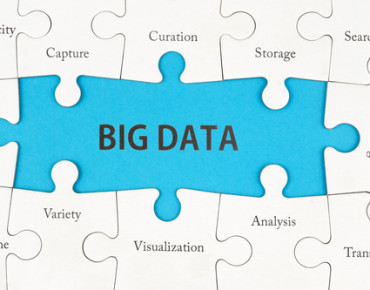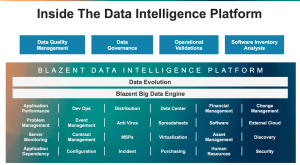Blazent Pulls Big Data Pieces Together

Despite the allure of analytics, many enterprises still struggle with siloed information in disparate formats, forced together via unwieldy manual processes that deliver only partial results. Combine this with the reality of shadow IT, incomplete knowledge about core systems, and the anticipated Internet of Things (IoT) explosion, and the promise of big data could fizzle for some enterprises.
Blazent hopes its new cloud-based big data platform and five-step evolution process will bring order to enterprises' data chaos.
Released on Wednesday, the Blazent Data Intelligence Platform includes a new big data engine; a process designed to ensure data quality in organizations' complicated environments, and new analytics and auditing modules for enterprises and managed service providers (MSPs).
"We help large enterprises – the IT organizations, the CIO and his or her team – to effectively manage the financial and operational performance of IT. We pull data from all the existing electronic sources both inside IT and outside IT to give an accurate view of what's going on," President and CEO Gary Oliver told Enterprise Technology. "It's not uncommon at all that the first time we light up, we sometimes find hundreds of servers on the network that IT didn't know about. Sometimes those servers might be missing core elements like backup and recovery or antivirus."
After locating core and unknown technology assets, Blazent provides IT with near-time data about people, process, and products, and places all IT information into one platform, the developer said. This creates a basis for an organization's predictive analytics and prescriptive modeling that's adaptive to data volume, velocity, and variety, Blazent said.
Technologies such as ActiveMQ, Cassandra, Hadoop, and Spark power the Blazent Data Intelligence Platform, which operates at near real-time speeds.
"We are utilizing the best-of-breed of many of the current big data technologies," said Michael Ludwig, Blazent chief product architect, in an interview. "There's a canonical flow that's happening inside the engine itself. Each of these incoming sources has its own data model: It can be stored rather granularly or it can be stored in a less complex fashion. Then we move onto identity management, where we have a number of sophisticated algorithms."
 The third step in the process is relationship management. The platform adds context to data, rather than just importing it from other sources. By reconciling service data with people and processes, organizations improve time to resolution and enhance productivity, said Oliver.
The third step in the process is relationship management. The platform adds context to data, rather than just importing it from other sources. By reconciling service data with people and processes, organizations improve time to resolution and enhance productivity, said Oliver.
Next, the platform tackles purification, where it takes all information from all sources and boils it down to a single record about a single entity, said Ludwig. The source-agnostic solution works with more than 230 data sources, and can process, correct, and resolve problems from an enterprise's existing tools, he said. As a result, organizations have a so-called Master Source of Truth or correct version of data they can use to verify information, mitigate risk, and remediate configuration errors, according to the developer.
Finally, in the histrocity layer, the Data Intelligence Platform takes and stores in Hadoop a record of every entity from every source across time. The system then uses this data as learning sets for predictive and prescriptive analytics, a solution Blazent expects to release later this year, Ludwig said.
On June 24, Blazent also unveiled two modules: Data Explorer for reporting and GLOVE – governance, lifecycle, operations, validation, and expenditure – for IT service governance and auditing. Data Explorer includes custom dashboards and reporting from aggregated data across more than 230 sources such as security solutions, monitoring tools, and service management software like ServiceNow. Aimed at MSPs that oversee many IT services and portfolios, GLOVE allows users to see the lifecycle status of billed entities and enables them to drill down into auditable fields such as account expenditures. MSPs also can use GLOVE for continuous audits to generate baselines and locate over- or under-billing.
One early GLOVE adopter, for example, found it had not billed a client for some services for two years, said Oliver. Another user of the Blazent Data Intelligence Platform discovered a previously unknown 30,000 servers operating on its network, he added.
"We bring all that data in and we'll make associations between things that have never associated before and that really provides that level of visibility," said Oliver. "Then we actually trigger off action."
Related
Managing editor of Enterprise Technology. I've been covering tech and business for many years, for publications such as InformationWeek, Baseline Magazine, and Florida Today. A native Brit and longtime Yankees fan, I live with my husband, daughter, and two cats on the Space Coast in Florida.










